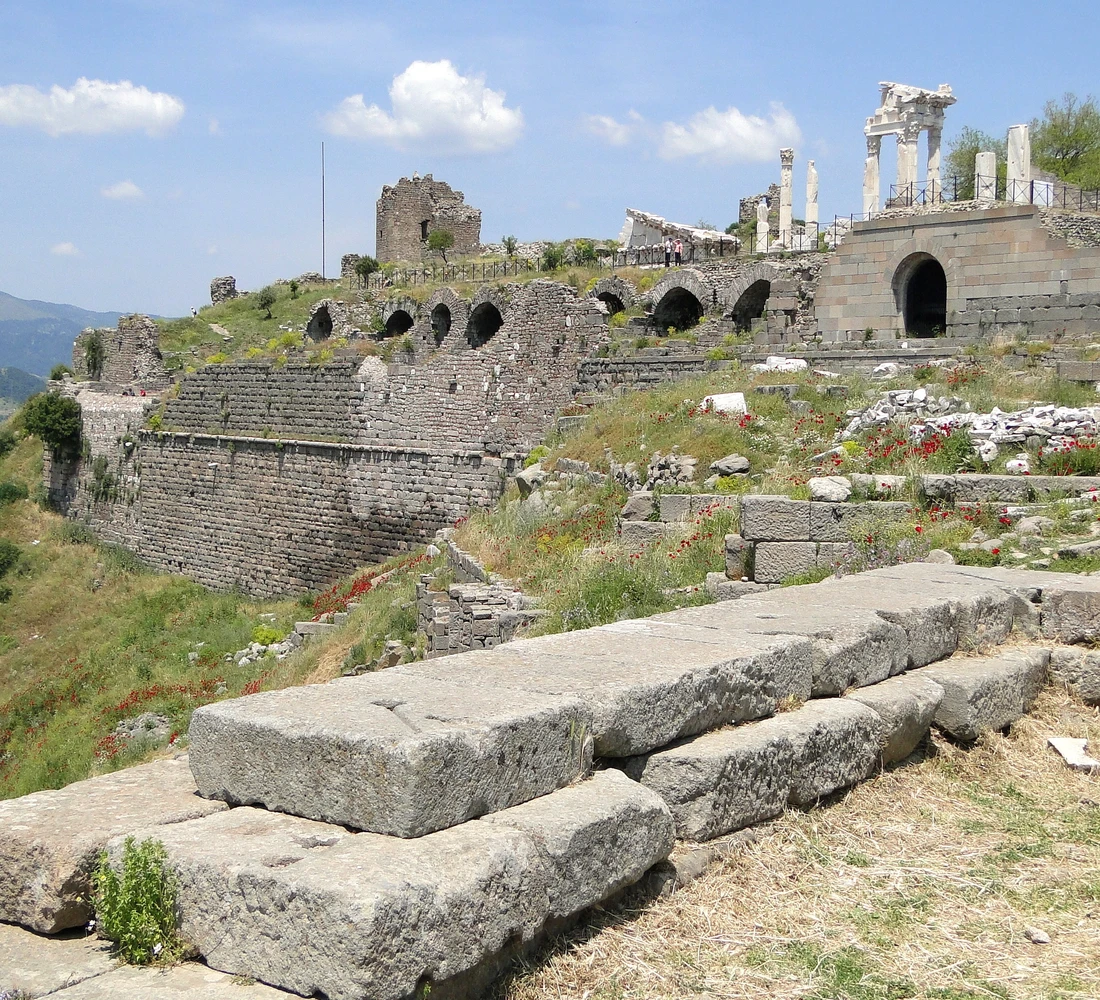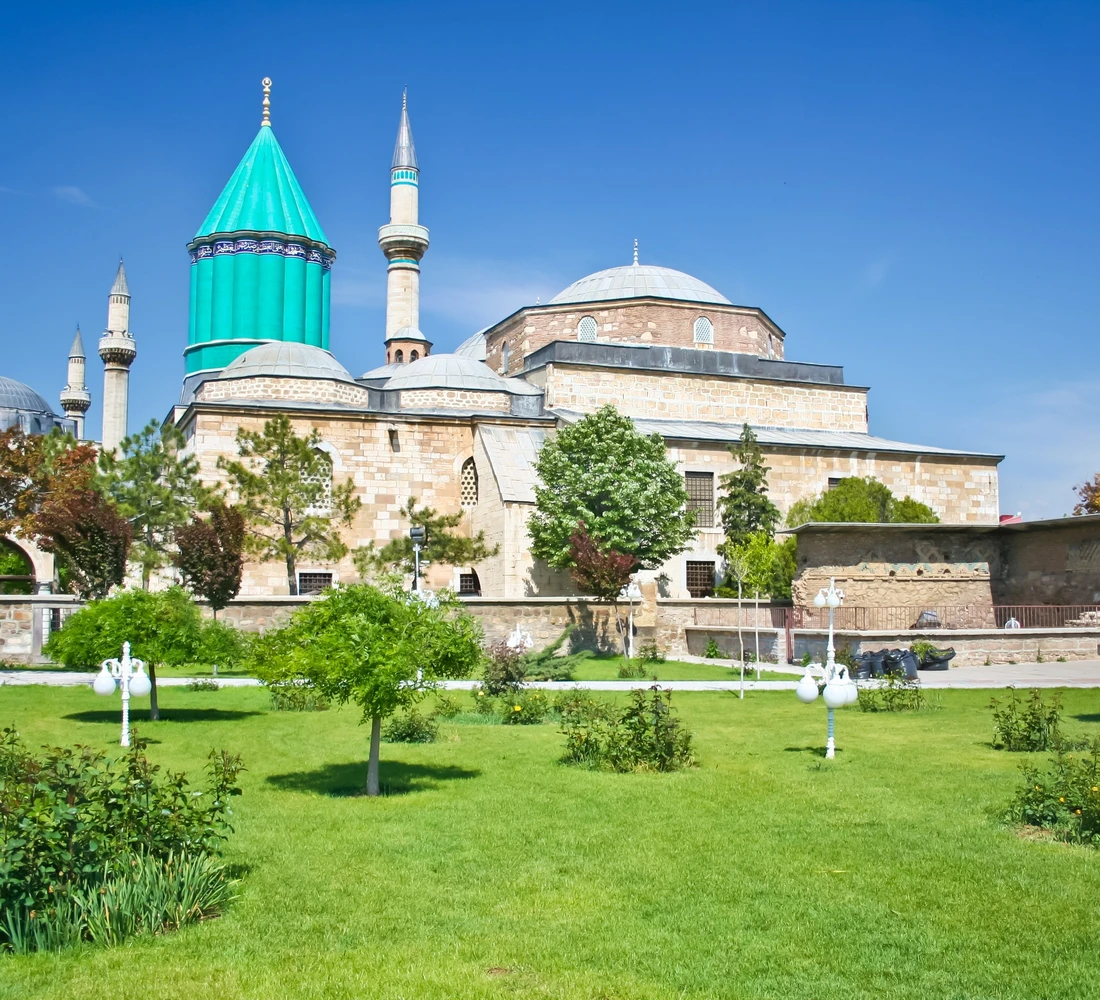Pergamon, the Roman city, stands as one of Turkey's most magnificent historical sites, where architectural genius and Hellenistic arts converge with a rich history spanning millennia.
Founded in the 8th century BC, the ancient city of Pergamon rose to its zenith during the Hellenistic and Roman periods, becoming a vital urban and cultural center that attracted scholars, artists, and philosophers from across the ancient world.
The city is renowned for its remarkable landmarks, including the Pergamon Altar, the Library of Pergamon, the Temple of Trajan in Pergamon, the Acropolis of Pergamon, the Pergamon Theatre, the Asclepion of Pergamon, and the Seven Churches of Asia in Pergamon.
Each of these landmarks reflects the splendor of Pergamon's ancient history and the grandeur of the Hellenistic Kingdom of Pergamon, highlighting the significance of the ancient Roman city of Pergamon in the legacy of human civilization.
Visiting the ruins of Pergamon in Turkey offers visitors a journey through time, enabling an understanding of social, religious, and political life in ancient eras.
Pergamon, the Roman City: Cradle of Civilization
Pergamon, the Roman city, is a unique cultural center in the Aegean region and a prominent example of ancient Roman cities.
The city flourished due to its strategic geographical location and was rich in temples, libraries, theaters, and amphitheaters that attracted numerous thinkers and artists.
Geography of Pergamon and its Strategic Importance
The ancient city of Pergamon is situated on high hills, offering a sweeping view of the surrounding areas, making it an ideal location for governance and military defense. This location was also distinctive as a link between trade routes between Asia and Europe, which contributed to its economic and cultural growth.
Thanks to this location, Pergamon, the Roman city, became a center for the exchange of knowledge and the arts, as well as a meeting point for trade caravans from various ancient empires.
Daily Life in Pergamon
Daily life in the ancient Roman city of Pergamon was vibrant, featuring vast markets, elaborate residences, magnificent royal palaces, as well as public gardens and recreational facilities.
The inhabitants of Pergamon participated in cultural and artistic events such as plays and religious ceremonies in the Acropolis of Pergamon, where each activity held social and religious symbolism.
The markets also provided a variety of goods, including wheat, spices, and luxurious textiles, reflecting the flourishing internal and external trade in the Hellenistic Kingdom of Pergamon.
The Hellenistic Kingdom of Pergamon: Power and Influence
During the Hellenistic period, the Hellenistic Kingdom of Pergamon emerged as an influential political and cultural force, especially during the reign of King Attalus II, who transformed the Hellenistic city of Pergamon into a global scientific and artistic center.
Culture and Arts
The Attalid Kingdom of Pergamon greatly supported the arts, leading to the construction of magnificent temples and palaces, including the Temple of Trajan in Pergamon and the Acropolis of Pergamon.
This support made Pergamon, the Roman city, a destination for artists and sculptors, with the city producing numerous artworks that reflected the Hellenistic prowess in painting, sculpture, and architecture.
Sciences and Education
The Library of Pergamon experienced significant development during the Hellenistic period of Pergamon, becoming one of the most prominent centers of knowledge in the ancient world, rivaling the renowned Library of Alexandria.
The library contained hundreds of thousands of manuscripts covering philosophy, mathematics, medicine, and astronomy, making Pergamon, the Roman city, an attraction for scholars from various parts of the ancient world.
The Pergamon Altar: An Architectural Masterpiece
The Pergamon Altar is one of the most prominent symbols of Pergamon, the Roman city, and a unique example of Hellenistic sculpture and architectural precision.
Altar Design and Inscriptions
The Pergamon Altar is characterized by its detailed inscriptions depicting the mythical battles between the gods and the giants, reflecting the Hellenistic understanding of art and religion alike.
The inscriptions reflect the spirit of the Hellenistic Kingdom of Pergamon and highlight the skill of the sculptors in creating spaces that narrate exquisite mythological stories.
Historical and Religious Significance
The Pergamon Altar was dedicated to the worship of the god Zeus, demonstrating the extent of religion's influence on politics and society in the ancient Roman city of Pergamon.
Today, the altar is displayed in the Pergamon Museum in Berlin, retaining its artistic and historical significance and serving as a testament to the greatness of Pergamon's ancient history.
The Library of Pergamon: A Beacon of Science
The Library of Pergamon is an important scientific and intellectual center, housing thousands of manuscripts covering various sciences.
Library Foundation
King Attalus II founded the Library of Pergamon in the second century BC to rival the Library of Alexandria, reflecting the scientific and cultural standing that the ancient Roman city of Pergamon held in the ancient world.
Library Influence
The library attracted thinkers and scholars from various countries, contributing to the dissemination of philosophy, science, and engineering, and elevating the status of Pergamon, the Roman city, as a global cultural center.
The library contained manuscripts in medicine, mathematics, and philosophy, making it a unique scientific center in the Attalid Kingdom of Pergamon.
Temple of Trajan in Pergamon: Emperor Worship
The Temple of Trajan in Pergamon is one of the most prominent Roman landmarks in the Acropolis of Pergamon, dedicated to the worship of Emperor Trajan and his wife Plotina.
Architectural Design
The temple features a luxurious Roman design and detailed inscriptions that depict the glories of the Roman Empire, a clear example of the intersection of architecture and religion in the ancient Roman city of Pergamon.
Historical Significance
The Temple of Trajan in Pergamon was a symbol of imperial power and official religion, demonstrating the extent of Roman culture's influence on religious architecture in Pergamon, the Roman city.
Acropolis of Pergamon: Summit of the City
The Acropolis of Pergamon represents the heart of the ancient city, where temples, fortresses, and public facilities converge.
Urban Planning
The Acropolis of Pergamon was meticulously organized in a geometric manner, combining governmental, religious, and cultural buildings, reflecting the importance of urban planning in the Hellenistic city of Pergamon.
Prominent Landmarks
The Acropolis includes the Roman Theatre, the Pergamon Altar, temples, and the King's Palace, becoming a center for political and religious life and highlighting the status of Pergamon, the Roman city, as one of the greatest cities in ancient history.
Pergamon Theatre: Roman Engineering
The Pergamon Theatre is a Roman engineering masterpiece that can accommodate approximately ten thousand spectators and features a panoramic location on the hills.
Design and Structure
The theater was constructed in a way that provides the best auditory and visual experience, reflecting the ingenuity of Roman engineers in the ancient Roman city of Pergamon.
Cultural Events
The theater was used to host religious celebrations and theatrical performances, serving as a symbol of cultural and artistic life in the Hellenistic Kingdom of Pergamon and demonstrating the role of Pergamon, the Roman city, in spreading the performing arts.
Asclepion of Pergamon: Cradle of Medicine
The Asclepion of Pergamon is considered one of the oldest medical centers in the world, serving as a center for medical education and patient treatment.
Treatment and Education
Doctors in the Asclepion of Pergamon used medicinal herbs and religious rituals to provide treatment, and the place was concerned with advanced medical education in ancient times.
Medical Impact
The center contributed to the development of concepts of mental and physical medicine, attracting patients from various parts of the Roman Empire, making the Asclepion of Pergamon a symbol of medicine in Pergamon, the Roman city.
Seven Churches of Asia in Pergamon: Religious Message
The Seven Churches of Asia in Pergamon are considered among the most prominent early Christian landmarks, and they are mentioned in the Book of Revelation.
Religious History
These churches were educational and religious centers, contributing to the spread of the Christian faith in Asia Minor, demonstrating the importance of the ancient Roman city of Pergamon in religious history.
Architecture and Symbolism
The churches were characterized by simple designs filled with religious symbols, making them an attraction for visitors and believers and highlighting the ancient history of Pergamon in spreading the religious and intellectual message.
Frequently Asked Questions: Exploring the Ancient Roman City of Pergamon
+
What are the most prominent landmarks of the ancient city of Pergamon ?
The most prominent landmarks include the Pergamon Altar, the Library of Pergamon, the Temple of Trajan in Pergamon, the Acropolis of Pergamon, the Pergamon Theatre, the Asclepion of Pergamon, and the Seven Churches of Asia in Pergamon.
+
Where is the archaeological site of Pergamon located ?
The archaeological site of Pergamon is located in the city of Bergama in the Izmir province of Turkey.
+
What is the history of the Hellenistic Kingdom of Pergamon ?
The Hellenistic Kingdom of Pergamon was founded in the third century BC and flourished under the rule of King Attalus II to become a vital urban and cultural center.
+
Can the ruins of Pergamon be visited in Turkey ?
Yes, the ruins of Pergamon can be visited in Turkey, and they are one of the most prominent tourist and historical destinations.
+
What is the significance of the Library of Pergamon ?
The Library of Pergamon is one of the greatest libraries in the ancient world, housing hundreds of thousands of manuscripts and serving as a center for science and knowledge.
Conclusion: Exploring the Ancient Roman City of Pergamon
Exploring the ancient Roman city of Pergamon is an unforgettable experience, a journey through history to understand Pergamon's ancient history, art, medicine, and religion.
Visiting its landmarks, such as the Pergamon Altar, the Library of Pergamon, the Temple of Trajan in Pergamon, the Acropolis of Pergamon, the Pergamon Theatre, the Asclepion of Pergamon, and the Seven Churches of Asia in Pergamon,
provides visitors with a rich cognitive experience and a deeper understanding of the role of the Attalid Kingdom of Pergamon and the Hellenistic city of Pergamon in shaping ancient Roman civilization, arts, and architecture.
Visiting Pergamon, the Roman city, and the ruins of Pergamon in Turkey is not merely a tourist trip but a cognitive journey that reflects the glory of history and the splendor of human civilizations.






